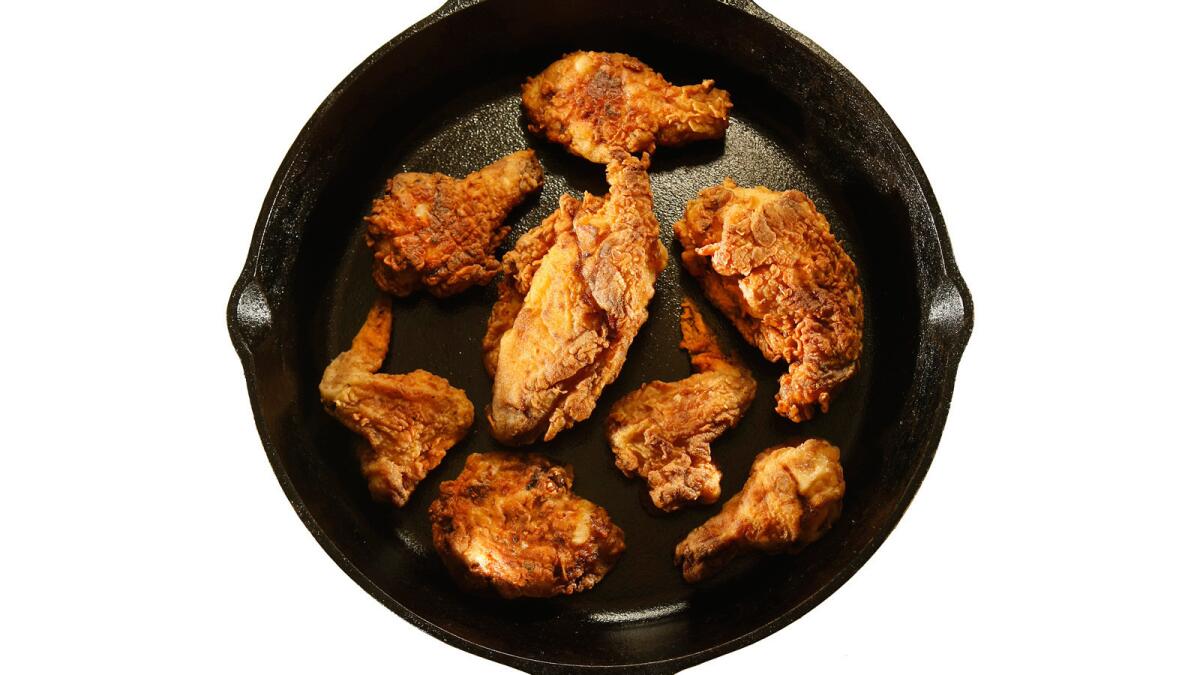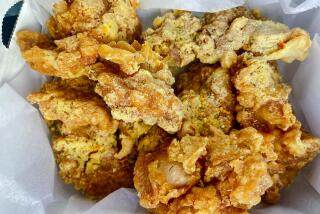Back to basics: Fried chicken, made at home

Fried chicken is a beautiful thing.
Nothing beats the simplicity of a tender, moist piece of meat, delicately seasoned and lightly dredged with a dusting of flour, and then baptized in a pool of sizzling fat to crisp, golden perfection.
Quintessential comfort food that it is, fried chicken is unpretentious. No haughty airs here. Eating with your fingers is not only acceptable, it’s all but required.
So maybe it’s a little surprising to find that fried chicken has become the hot culinary muse of the moment. Chefs, meet Eliza Doolittle. Fine cuisine, meet fried chicken.
One look at the recent crop of cookbooks tells you that chefs everywhere are jumping on the fried chicken bandwagon. Thomas Keller’s Ad Hoc recipe may look homey, but there’s an unmistakable air of educated refinement. The Bromberg brothers’ cookbook from their restaurant Blue Ribbon reinvents the Southern staple as “Northern Fried Chicken,” breaded with matzo and dipped in honey.
And then there’s David Chang, whose recipe in the Momofuku cookbook tosses out the crust altogether. Instead, the steamed birds, without batter, are treated to a skinny dip in hot oil before being dressed with a glossy, tart vinaigrette.
It all kinda feels like “Project Runway.” But with chicken.
While lovers of classic fried chicken agree that the dish may be basic, they’ll also acknowledge that good fried chicken requires technique, time and dedication. Good fried chicken is not “fast food.”
But what exactly is that perfect technique? This is where fans disagree. Everyone has the one true method for perfect fried chicken. And everyone else’s is heretical.
After a couple of weeks testing recipe after recipe, I have some very firm opinions of my own. And some super-greasy clothes.
Good fried chicken starts with a good bird. Yeah, it may sound like a no-brainer, but you’ll taste the difference. Bred mainly for size and appearance, too many commercial chickens suffer from a terrible lack of personality. If you want flavor, spend a few extra bucks on a quality bird.
And yes, size does matter. Many classic fried chicken recipes call for pullets — young small hens. Even many newer recipes call for smaller birds, somewhere in the range of 21/2 to 31/2 pounds. Many modern chickens weigh as much as twice that.
Not good. With fried chicken, you’ve got to cook the meat to moist tenderness in the time it takes the outer crust to fry to a crisp golden brown. Too large a bird and the crust might over-color (read: burn) before the meat cooks through.
Try game hens
One trick I found is using Cornish game hens instead of chicken. The flavor is good and they’re small enough that the meat cooks through without burning the crust. Substitute a couple of game hens for a standard chicken called for in a recipe; they usually come in packs of two, which makes it even easier.
So what about seasoning? Some recipes call for a brine. Though brines can be great for adding flavor and moisture, if you use good birds and cook them properly, they’ll stay moist. And there are other ways to season.
My favorite seasoning is a simple dry rub. Season the bird with salt and just a few ingredients — don’t complicate things — then toss it in a bowl and refrigerate the pieces to give the rub time to work. The seasoning will have plenty of time to soak through the meat overnight. I’ll use salt, garlic, a chopped fresh herb or two and a little acid (I like to use a little fresh citrus juice and zest).
The next morning, toss a couple of cups of buttermilk in the bowl and marinate the chicken for a few hours to lend a little extra flavor. The bird won’t be in the buttermilk long enough to tenderize the meat, but the buttermilk will add nice tang.
About an hour before frying, gently shake the pieces free of the buttermilk and dredge. The classic coating is a little seasoned flour, which works just fine — a light coat sticks to the buttermilk, giving it a nice, not too thick crust. For a thicker crust, dredge again (dip the piece in a buttermilk or egg wash first, or let it dry a bit, then dredge again).
For some fans, fried chicken is all about the crust. For an extra-crisp, crackly crust, use cornstarch in place of some of the flour. Cornstarch is often used in Asian frying and lends a light, crisp crunch. A little baking powder is also great for lightening the texture. Season the bird a little more generously so the flavor stands up to the crust.
Or shake up the dredge a bit for flavor. Corn flour adds a nice sweetness, and cornmeal gives a little extra crunch.
When the pieces are ready, let them sit at room temperature for a while to give the crust time to dry and take the chill off the meat.
Can’t beat lard
For frying, there’s nothing better than lard. Maybe it’s the flavor, maybe there’s something to the way the fat reacts with the crust, but lard is a magical frying medium. (And there’s a little hint of pork in every bite.)
You can also use a neutral, refined oil with a high smoking point, such as canola or vegetable; peanut oil is often preferred for its high smoking point. If you’d like, flavor the fat before adding the chicken by frying an onion, or some ham or bacon.
Chicken can be either pan-fried, or deep-fried. Unless I’m going for a thick, light crust where I need enough oil to keep the chicken suspended, I prefer to pan-fry. It dirties less oil, and it’s easy to monitor all of the pieces frying at once. Use a good, heavy skillet to evenly distribute the heat (and I swear by cast iron the same way I swear by lard).
To pan-fry, melt enough fat in a skillet to come a good half to three-fourths inch up the side of the pan, and heat the fat to the right temperature, generally between 300 and 350 degrees. Too low, and the oil will soak into the crust rather than fry it; too high, and the crust might burn before your chicken is done. Use a thermometer to keep the heat at a consistent temperature, and make sure you’ve got a good, heavy skillet to evenly distribute the heat.
Fry the pieces until the crust is crisp and golden-brown and the meat is tender, anywhere from six to 10 minutes a side depending on the size of the piece (remember, white meat cooks more quickly than dark). Some recipes call for covering the pan with a lid while frying; although this helps retain heat and maybe cooks the pieces a little faster, I find it makes for a crust that’s less crisp.
Drain the crisp chicken, then serve it hot. Or better still, let it sit awhile to allow the flavors to mellow and marry. After all, doesn’t comfort food sometimes taste best the next day? Or perhaps in the middle of the night, by the light of the fridge?
Yeah, it’s a beautiful thing.
More to Read
Eat your way across L.A.
Get our weekly Tasting Notes newsletter for reviews, news and more.
You may occasionally receive promotional content from the Los Angeles Times.











